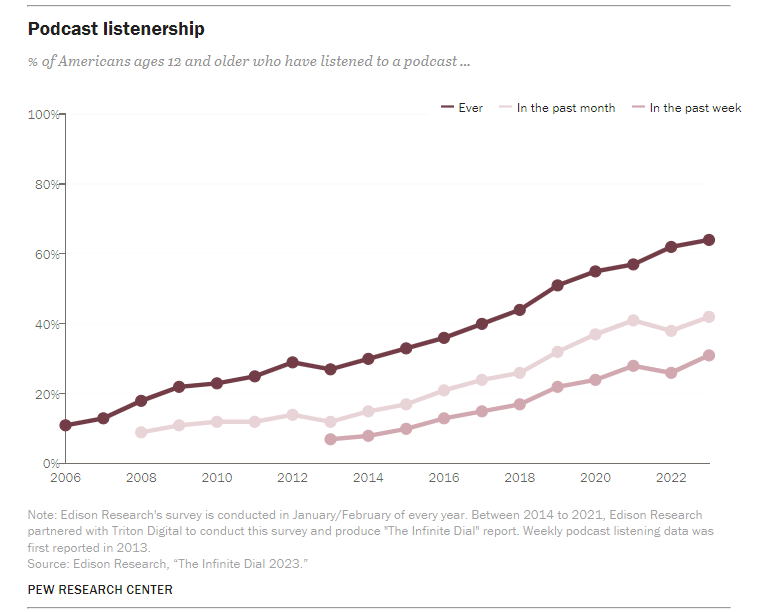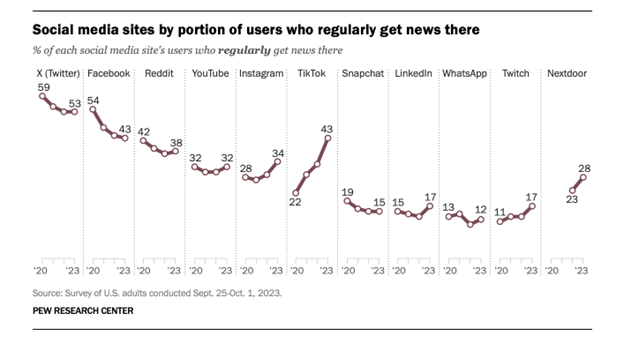Beyond the Press And Into the Diverse Landscape of News Channels and Platforms
Navigating the diverse landscape of news channels and platforms has become increasingly complex. From traditional newspapers to social media snippets, the way your audience consumes news has transcended the limitations of the traditional press. As they strive to stay informed, the options have expanded exponentially, offering both a bounty of choice and a minefield of misinformation.
The recent Pew Research reports on media consumption in the US have some interesting insights.
Newspapers
Newspapers are a still a critical part of the American news landscape, but they have been hit hard as more and more Americans consume news digitally. The industry’s financial fortunes and subscriber base have been in decline since the mid-2000s, and their website audience traffic has begun to decline as well.
Digital News
According to the November Pew Research report, most adults in the United States get at least some news from digital devices. The online space has become a host for the digital homes of both legacy news outlets and new, “born on the web” news outlets.
These new outlets have several options for reaching their consumers online, including apps, newsletters, podcasts, and aggregation platforms like Apple News or Flipboard.
Podcasts
The share of Americans who listen to podcasts has substantially increased over the last decade. As of 2023, 42% of Americans ages 12 and older have listened to a podcast in the past month.
Discovering which podcasts your audience is listening to could give you a very useful edge.
Audience analysis and tracking can help you with this. Here is some data provided by SparkToro for an audience that talks about nutrition and health.
And these are the top five podcasts they listen to.
Understanding the modern news landscape
As you delve into the many ways news reaches your audience, it becomes evident that media consumption habits have evolved dramatically. Whether through podcasts, live streams, or curated social media feeds, the options are vast—and so are the considerations when evaluating their credibility. Join us as we navigate the ever-expanding universe of news channels and platforms, dissecting the landscape to uncover the most reliable sources amidst the chaos.
The modern news landscape is a complex tapestry woven from traditional and digital threads, each contributing to the information we consume daily.
The impact of social media on news consumption
In the age of social media, news consumption has undergone a paradigm shift. Today, half of U.S. adults get news at least sometimes from social media.
Some social media sites – despite having relatively small overall audiences – stand out for having a high share of users who regularly go to the site for news. For example, roughly half of users on X (53%) get news there.
And one to watch is TikTok- their audience for news is growing faster than any other social media platform.
You may think that your audience is not on TikTok but take a look at this chart of demographics. You may find that your audience is indeed on TikTok!
Niche news channels and platforms
Beyond the mainstream, niche news channels and platforms cater to specialized interests and communities, offering tailored content that may not garner attention in traditional media outlets.
These platforms encompass everything from industry-specific newsletters to independent journalism collectives, providing in-depth coverage of topics often overlooked by larger publications. Niche news channels play a vital role in diversifying the news ecosystem, amplifying voices that might otherwise be marginalized and fostering a more inclusive media landscape.
In embracing niche news channels, consumers gain access to nuanced perspectives and expert analysis within their areas of interest, transcending the homogeneity often found in mainstream news coverage.
However, discerning the credibility of niche platforms is paramount, as the absence of established editorial standards can present challenges in verifying the accuracy and integrity of their reporting. Engaging with niche news channels requires a discerning eye and a willingness to explore diverse sources, enriching one's understanding of complex issues and underrepresented narratives.
Personalized news experiences
Personalization has emerged as a defining feature of modern news consumption, shaping the way individuals interact with and internalize information. From tailored news alerts to customized content recommendations, personalized news experiences cater to the individual preferences and habits of news consumers, delivering a curated stream of information that aligns with their interests. While this customization enhances user engagement and satisfaction, it also raises questions about the potential for algorithmic bias and the erosion of serendipitous discovery.
The prevalence of personalized news experiences underscores the need for media literacy and critical thinking, empowering individuals to discern between personalized content and a comprehensive understanding of diverse viewpoints.
Moreover, as news algorithms shape the information individuals encounter, transparency and accountability in algorithmic processes become essential to maintain trust and integrity in personalized news delivery. Balancing the benefits of personalization with the preservation of information diversity is a pivotal consideration in the evolving landscape of news consumption.
News credibility and fact-checking in the digital age
This is an era rife with misinformation and disinformation. Assessing the credibility of news sources is paramount. Fact-checking, long upheld as a cornerstone of journalistic integrity, takes on renewed significance in the digital age, where the rapid dissemination of unverified information can have far-reaching consequences. As news consumers, cultivating a discerning approach to evaluating the credibility of sources and scrutinizing the veracity of claims is imperative in navigating the deluge of information confronting us daily.
Fact-checking initiatives and organizations play a pivotal role in combatting misinformation, providing verifiable evidence and context to counter false or misleading narratives. Equipping oneself with fact-checking tools and resources empowers individuals to critically engage with news, contributing to a more informed and vigilant society. Moreover, advocating for transparency and accountability in news reporting reinforces the importance of ethical journalism and upholds the public's right to accurate and reliable information.
Adapting your PR strategy for diverse news platforms
In navigating the diverse landscape of news channels and platforms, you need to adapt your strategies to effectively engage with varied audiences and mediums. Data and analytics is the most effective method of doing this.
Understanding the distinct characteristics and preferences of each platform is essential in crafting tailored PR campaigns that resonate with diverse news consumers.
Whether targeting traditional print media, digital news outlets, or niche platforms, as a PR professional it is imperative that you use a nuanced approach informed by data that aligns with the unique dynamics of each audience and each channel.
Leveraging data analytics and audience insights can inform PR strategies, guiding the selection of platforms and the customization of messaging to maximize impact. By identifying the most relevant channels for their target audiences and tailoring their narratives to suit different platforms, you can optimize the reach and engagement of your news content, amplifying your brand’s visibility across the multifaceted news landscape.
Adapting PR strategies for diverse news platforms demands flexibility, adaptability, and a deep understanding of the evolving media ecosystem.




